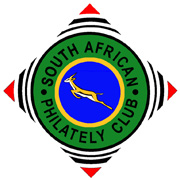Siege of Ladysmith - South African Postcard Interest Group (SAPIG)
Quote from Steve on May 31, 2025, 12:06 pmThere is a new South African Postcard Interest Group (SAPIG) which has already had four very successful meetings. If you wish to participate in the group which is informal and friendly you are very welcome to join its Zoom meetings.
The go-to guy is Andre du Plessis RDPSA. He is the COO (Chief Operations Officer, I guess) of the PFSA (Philatelic Federation of SA). Do not let that put you off. He is deeply into postcards and appears to be having some sort of conversion fir currently. He spent some time at the last meeting apologising for feeling a bit ambivalent toward philately, essentially stamps. None of us thought to blame him
Andre Du Plessis RDPSAEmail: <pfsastamps@gmail.com>TEL: 083 399 1755 (SA)The ZoomMeetingsa have all been held at 17.00 GB time, 18.00 in SA. Most Zoom meetings are socially disruptive and awkwardly timed. The SAPIG meetings are much more convenient for UK attendees. One still has enough time to cook and eat dinner afterwards.From my side, I have found that I have a greater love of postcards than of stamps. With their images of long-lost views of people, places and social circumstances, postcards are items of historic paper-based archaeology that give us a clue to our shared, collective past. Sadly, and I write for myself here, stamps are over-priced scraps of colourful paper of no intrinsic worth whatsoever. Still, many people still collect them and pay thousands of pounds for the pleasure they give but I am not one of them. I like a pretty stamp on cover accompanied by a decent strike of the postmark. I am not sorry! As a historian postcards, postmarks and covers excite me most.I have seen enough in the SAPIG meetings to want to attend every meeting in future.
I will post full details of the meetings here. Watch this space.
There is a new South African Postcard Interest Group (SAPIG) which has already had four very successful meetings. If you wish to participate in the group which is informal and friendly you are very welcome to join its Zoom meetings.
The go-to guy is Andre du Plessis RDPSA. He is the COO (Chief Operations Officer, I guess) of the PFSA (Philatelic Federation of SA). Do not let that put you off. He is deeply into postcards and appears to be having some sort of conversion fir currently. He spent some time at the last meeting apologising for feeling a bit ambivalent toward philately, essentially stamps. None of us thought to blame him
I have seen enough in the SAPIG meetings to want to attend every meeting in future.
I will post full details of the meetings here. Watch this space.
Quote from Steve on May 31, 2025, 12:34 pmSiege of Ladysmith Postcards 1.
The following is based on an edited PowerPoint AI-generated Summary from the first SAPIG (SA Postcard Interest Group) Zoom Meeting that attended held on 25th March 2025. To join this group, please Contact Andre du Plessis at the PFSA.
The meeting covered two lots of Natal postcards. The first were printed in Ladysmith during the Siege that took place during the South African War (aka Anglo-Boer War, 1899 1902). These are the only postcards that can correctly be called "Siege of Ladtsmith postcards". They are a specialist collecting field. Those that follow this display below in the "Background to the Siege" are more in the vein of town views and cabinet cards.
The presenter of these 'Siege of Ladtsmith postcards" was John Handman in SA. Keith Klugman RDPSA FRPSL in Seattle, USA, presented Early Natal illustrated Colour postcards.
1900. Postcard. LADYSMITH ‘MR 6 1900’ to VERULAM ‘ 9 MR 1900’.
Routed via DURBAN ‘9 MR 1900’.
An example of the front of the first issue postcard with two soldiers, right.John Handman described his interest in the Siege of Ladysmith which was sparked by his family’s involvement, one on either side. He shared his collector’s knowledge of the siege postcards, including their design, paper, printing, and postal rates.
Versions of the Siege Postcard
John mentioned two distinct cards produced during the siege, with the first one featuring two figures at the bottom. John noted the cards’ varying sizes, thicknesses, and ink colors, attributing these differences to the limited resources available during the siege.
1900. Postcard. LADYSMITH ‘MR 6 1900’ to VERULAM ‘ 9 MR 1900’.
An example of the back of the first issue postcard. Written in old Tamil, apparently.John presented the second version of the postcard produced during the siege. He pointed out the addition of an extra figure representing the Natal volunteers bottom right and small changes to the design, including ‘ZAR’ on the hat of General Piet Joubert.
John compared the first and second printed cards, noting specific changes such as the smoke from the cannon, the badge on Joubert’s hat, and the positioning of ‘Long Tom’. There are also changes to the reverse card, including the font used and the flag flying defiantly above the damaged town hall. The flag is smaller and more solid, more ‘Swiss’.
Postcard History and Design Discussion
While John’s various examples were of the common red variety, he did show a black one. He also had one ‘unique card’ with a handwritten message thought to be in Tamil posted to a teacher in Verulam, Natal, as well as some bearing British stamps. Mention was also made of the possible designer of the postcards. Generally, the design of the postcards if not the publishing of the postcards themselves is attributed to Earl Robert, an illustrator, possibly also a journalist, who was known to work on the Ladysmith Bombshell, the town’s siege newspaper. John is not fully convinced that Robert published these postcards but cannot with confidence suggest who else it might be.Andre and John Kramer asked questions about the postcard’s design and variations. Alan Harley mentioned an article by Duggan in the Anglo-Boer War Journal that breaks down the postcards into six different varieties and suggests the existence of a blue version. John Handman expressed interest in reading the article and seeing, if not, acquiring the blue version.
Siege of Ladysmith Postcards continued below.......
Siege of Ladysmith Postcards 1.
The following is based on an edited PowerPoint AI-generated Summary from the first SAPIG (SA Postcard Interest Group) Zoom Meeting that attended held on 25th March 2025. To join this group, please Contact Andre du Plessis at the PFSA.
The meeting covered two lots of Natal postcards. The first were printed in Ladysmith during the Siege that took place during the South African War (aka Anglo-Boer War, 1899 1902). These are the only postcards that can correctly be called "Siege of Ladtsmith postcards". They are a specialist collecting field. Those that follow this display below in the "Background to the Siege" are more in the vein of town views and cabinet cards.
The presenter of these 'Siege of Ladtsmith postcards" was John Handman in SA. Keith Klugman RDPSA FRPSL in Seattle, USA, presented Early Natal illustrated Colour postcards.

1900. Postcard. LADYSMITH ‘MR 6 1900’ to VERULAM ‘ 9 MR 1900’.
Routed via DURBAN ‘9 MR 1900’.
An example of the front of the first issue postcard with two soldiers, right.
John Handman described his interest in the Siege of Ladysmith which was sparked by his family’s involvement, one on either side. He shared his collector’s knowledge of the siege postcards, including their design, paper, printing, and postal rates.
Versions of the Siege Postcard
John mentioned two distinct cards produced during the siege, with the first one featuring two figures at the bottom. John noted the cards’ varying sizes, thicknesses, and ink colors, attributing these differences to the limited resources available during the siege.
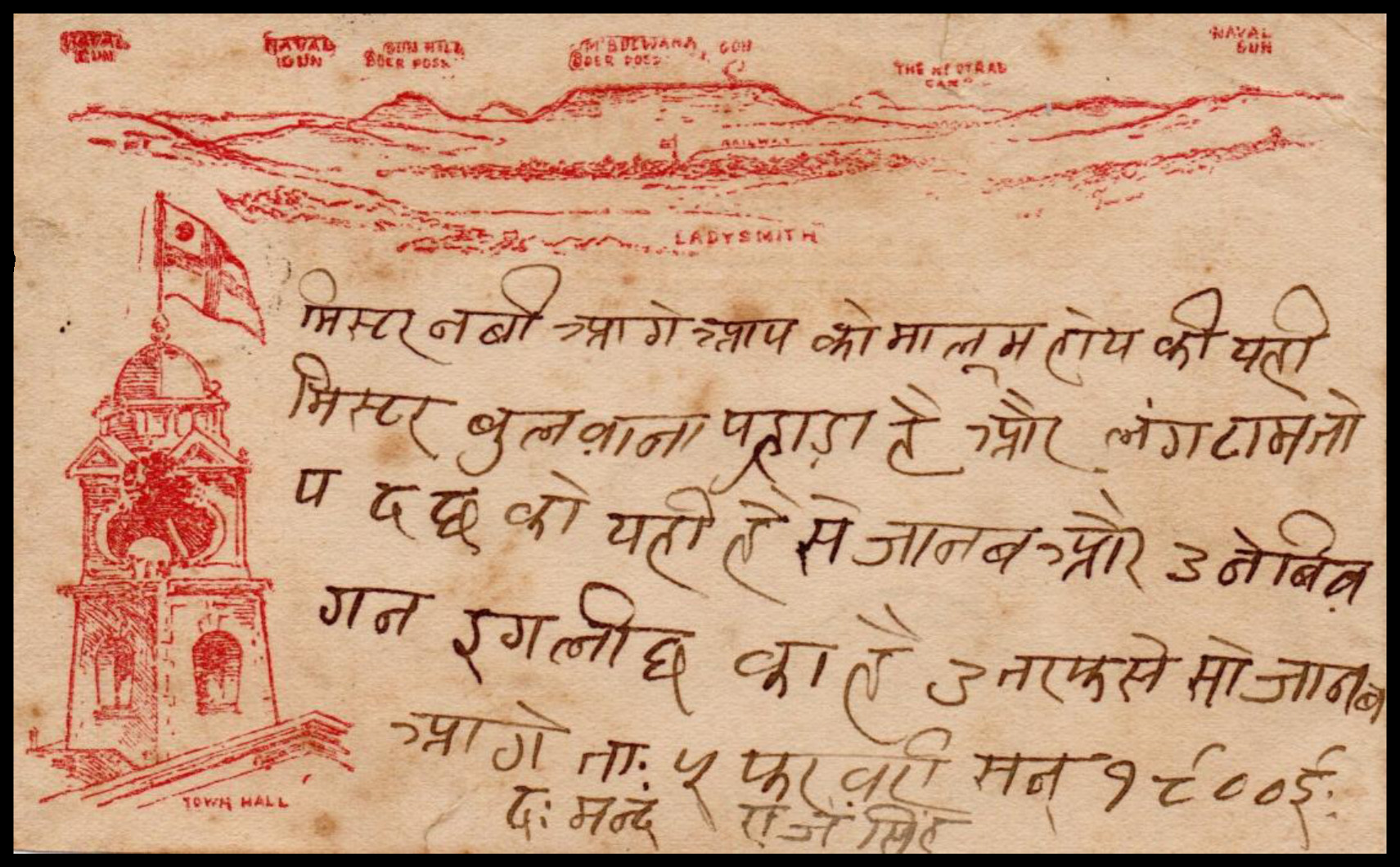
1900. Postcard. LADYSMITH ‘MR 6 1900’ to VERULAM ‘ 9 MR 1900’.
An example of the back of the first issue postcard. Written in old Tamil, apparently.
John presented the second version of the postcard produced during the siege. He pointed out the addition of an extra figure representing the Natal volunteers bottom right and small changes to the design, including ‘ZAR’ on the hat of General Piet Joubert.
John compared the first and second printed cards, noting specific changes such as the smoke from the cannon, the badge on Joubert’s hat, and the positioning of ‘Long Tom’. There are also changes to the reverse card, including the font used and the flag flying defiantly above the damaged town hall. The flag is smaller and more solid, more ‘Swiss’.
Postcard History and Design Discussion
While John’s various examples were of the common red variety, he did show a black one. He also had one ‘unique card’ with a handwritten message thought to be in Tamil posted to a teacher in Verulam, Natal, as well as some bearing British stamps. Mention was also made of the possible designer of the postcards. Generally, the design of the postcards if not the publishing of the postcards themselves is attributed to Earl Robert, an illustrator, possibly also a journalist, who was known to work on the Ladysmith Bombshell, the town’s siege newspaper. John is not fully convinced that Robert published these postcards but cannot with confidence suggest who else it might be.
Andre and John Kramer asked questions about the postcard’s design and variations. Alan Harley mentioned an article by Duggan in the Anglo-Boer War Journal that breaks down the postcards into six different varieties and suggests the existence of a blue version. John Handman expressed interest in reading the article and seeing, if not, acquiring the blue version.
Siege of Ladysmith Postcards continued below.......
Quote from Steve on June 3, 2025, 10:32 amSiege of Ladysmith Postcards 2.
The new South African Postcard Interest Group (SAPIG) held a Zoom Meeting on Tuesday 25th March 2025 in which John Handman in South Africa presented Siege of Ladysmith postcards. See above. They are generally attributed to Earl Robert who arrived in SA in 1892. Robert is known to have been the illustrator of The Ladysmith Bombshell siege newspaper.
Background to the Siege of Ladysmith: 2nd Nov 1899 – 28th Feb 1900
The South African War (Anglo-Boer War) began on 11th October 1899.
Circa 1900. French Postcard. President Paul ZAR Kruger & General Joubert’.
The fighting centred around the railway leading into the OFS and ZAR.Realising that negotiations with the British were going nowhere and knowing that a large British Army was en route to South Africa by sea, the Republican governments of the ZAR (South African Republic aka Transvaal) and the Orange Free State, under the leadership of their respective Presidents, Paul Kruger and Martinus Steyn, declared war on the British Empire. They hoped to gain an advantage from a decisive pre-emptive attack on British forces in the British colonies of the Cape and Natal who were gathering to invade their republics.
Circa 1902. Postcard. ‘Ladysmith’. (P. S. & C., Durban. No. 15/11.)
Presumably the building with the clock tower is the Town Hall.British General Sir George White arrived in Durban from India on 7th October to command the British forces in Natal. (In India, White had taken over from Lord Roberts.) General Sir Redvers Buller was appointed overall Commander-in-Chief of British forces in South Africa, a position he held during the early months of the conflict before being replaced by Lord Roberts. Bullers various failures in the early campaign in South Africa, especially his inability to relieve Ladysmith, would see him nicknamed 'Reverse' Buller.
1900. Magazine. (Not a Postcard!) 'The Theatre of War' showing the Commanders of the Opposong Forces.
Left. Republican Commandant General Piet Joubert. Right British CiC General Sir Redvers'Reverse' Buller VC.White correctly believed that he should withdraw from north-western Natal, but was dissuaded not to by the Natal governor, Sir Walter Hely-Hutchinson, who feared the political consequences. He was supported by General Sir William Penn Symons who believed that a small force based at Glencoe, north-east of Ladysmith, would be enough to deter the Boers. It was agreed that Symons would garrison Glencoe while White made Ladysmith his base.
Ladysmith Bulwana Hill
Circa 1902. Postcard. Bulwana Hil – Ladysmith. (Sallo Epstein & Co., Durban. No 1850.)
General Piet Joubert, the Republican commander, established his HQ on Bulwana Hill.
This view is looking to the south-east. In the centre left is the railway yard.Some 21,000 Boers advanced into northern Natal from the OFS and ZAR. Being too close to the borders, White’s forces were exposed in the triangle of land lying between the two Boer republics. Penn Symons’ force at Glencoe and nearby Dundee fought and won the Battle of Talana Hill on 20th October. However, Penn Symons was mortally wounded and died later in Dundee. He was succeeded by General James Yule. After the Boers captured the railway station at Elandslaagte and severed communications with White, the Battle of Elandslaagte was fought on the following day, the 21st October.
Circa 1906. ‘Real photo’ postcard. Elandslaagte’.
White ordered Major General John French and his cavalry to clear the railway line and restore telegraph communications at Elandslaagte. French’s cavalry were victorious but gained no strategic advantage from the engagement at Elandslaagte. Fearing a further invasion of Boers from the Orange Free State, White decided to withdraw all his forces to Ladysmith. When Yule learned of the situation at Elandslaagte he abandoned Dundee and Glencoe on 22nd October and retreated post hast to Ladysmith in order to avoid being encircled and to reinforce White. Yule’s men reached Ladysmith on 26th October.
Circa 1902. Postcard. ‘Town Hall, Ladysmith’. (G. B. & Co. No 377.)
The clock tower was not repaired until the late 1920s.The Republicans slowly began to surround Ladysmith. In response White ordered a sortie by the Ladysmith garrison on 30th October against the surrounding Boer forces with the aim of capturing or destroying the Boer artillery. The resulting Battle of Ladysmith was a demoralising British defeat for the town’s garrison. In what would be a feature of the siege as illustrated on the Siege of Ladysmith postcards the first of many Boer heavy artillery shells from ‘Long Tom’ on Pepworth Hill landed in the town, causing some panic.
Siege of Ladysmith Postcards Continued below....
Siege of Ladysmith Postcards 2.
The new South African Postcard Interest Group (SAPIG) held a Zoom Meeting on Tuesday 25th March 2025 in which John Handman in South Africa presented Siege of Ladysmith postcards. See above. They are generally attributed to Earl Robert who arrived in SA in 1892. Robert is known to have been the illustrator of The Ladysmith Bombshell siege newspaper.
Background to the Siege of Ladysmith: 2nd Nov 1899 – 28th Feb 1900
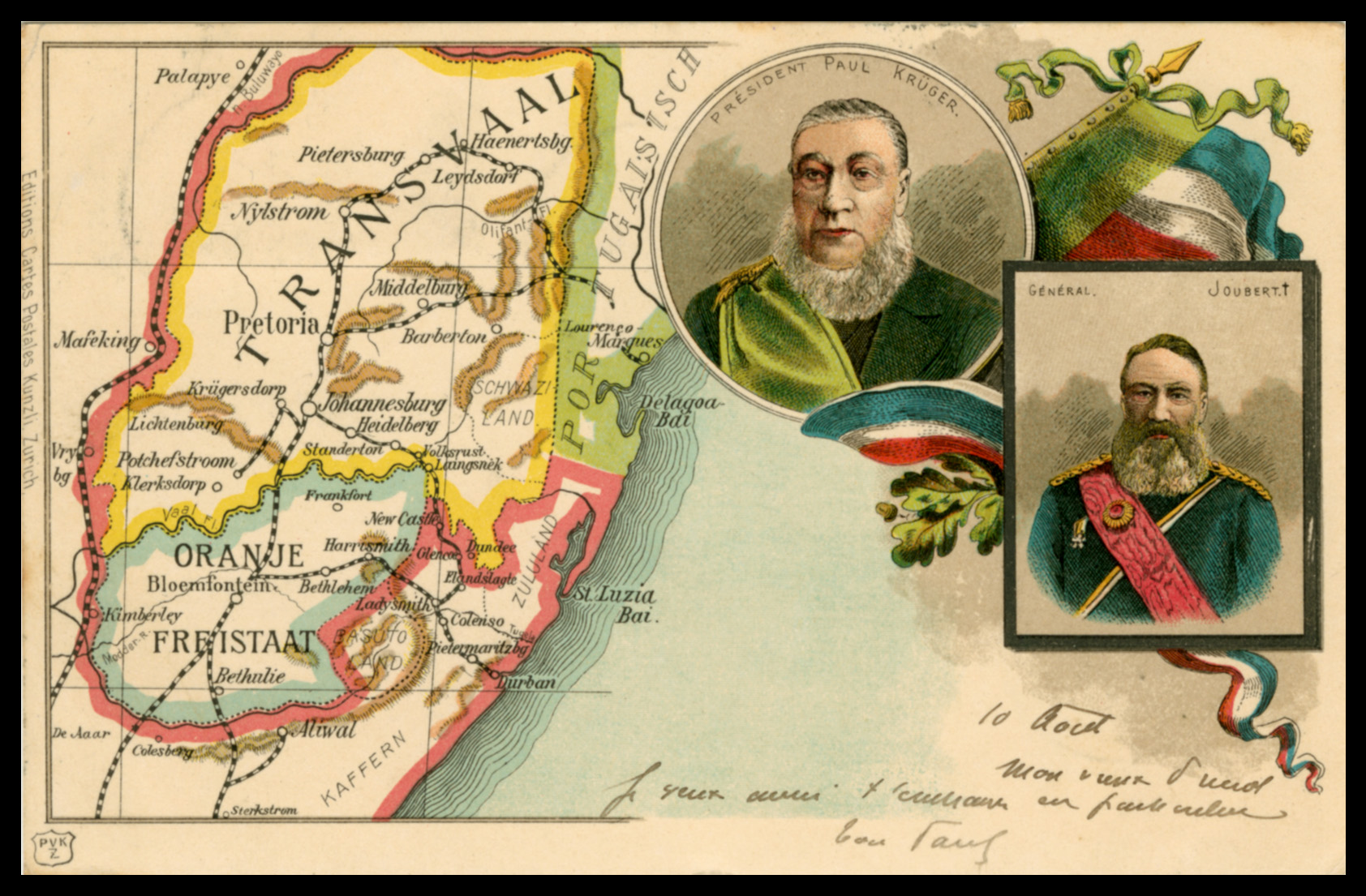
The South African War (Anglo-Boer War) began on 11th October 1899.
Circa 1900. French Postcard. President Paul ZAR Kruger & General Joubert’.
The fighting centred around the railway leading into the OFS and ZAR.
Realising that negotiations with the British were going nowhere and knowing that a large British Army was en route to South Africa by sea, the Republican governments of the ZAR (South African Republic aka Transvaal) and the Orange Free State, under the leadership of their respective Presidents, Paul Kruger and Martinus Steyn, declared war on the British Empire. They hoped to gain an advantage from a decisive pre-emptive attack on British forces in the British colonies of the Cape and Natal who were gathering to invade their republics.
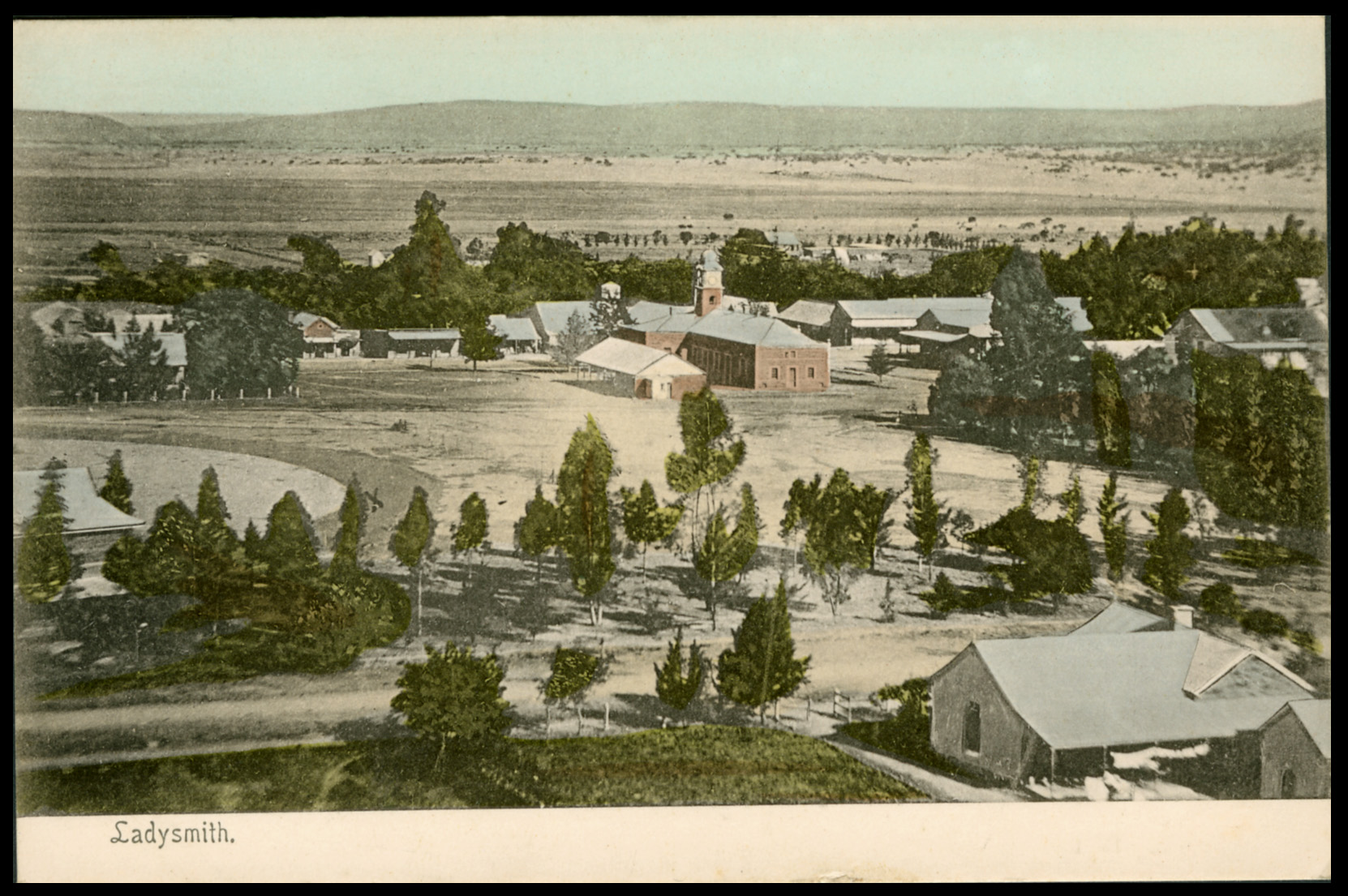
Circa 1902. Postcard. ‘Ladysmith’. (P. S. & C., Durban. No. 15/11.)
Presumably the building with the clock tower is the Town Hall.
British General Sir George White arrived in Durban from India on 7th October to command the British forces in Natal. (In India, White had taken over from Lord Roberts.) General Sir Redvers Buller was appointed overall Commander-in-Chief of British forces in South Africa, a position he held during the early months of the conflict before being replaced by Lord Roberts. Bullers various failures in the early campaign in South Africa, especially his inability to relieve Ladysmith, would see him nicknamed 'Reverse' Buller.

1900. Magazine. (Not a Postcard!) 'The Theatre of War' showing the Commanders of the Opposong Forces.
Left. Republican Commandant General Piet Joubert. Right British CiC General Sir Redvers'Reverse' Buller VC.
White correctly believed that he should withdraw from north-western Natal, but was dissuaded not to by the Natal governor, Sir Walter Hely-Hutchinson, who feared the political consequences. He was supported by General Sir William Penn Symons who believed that a small force based at Glencoe, north-east of Ladysmith, would be enough to deter the Boers. It was agreed that Symons would garrison Glencoe while White made Ladysmith his base.
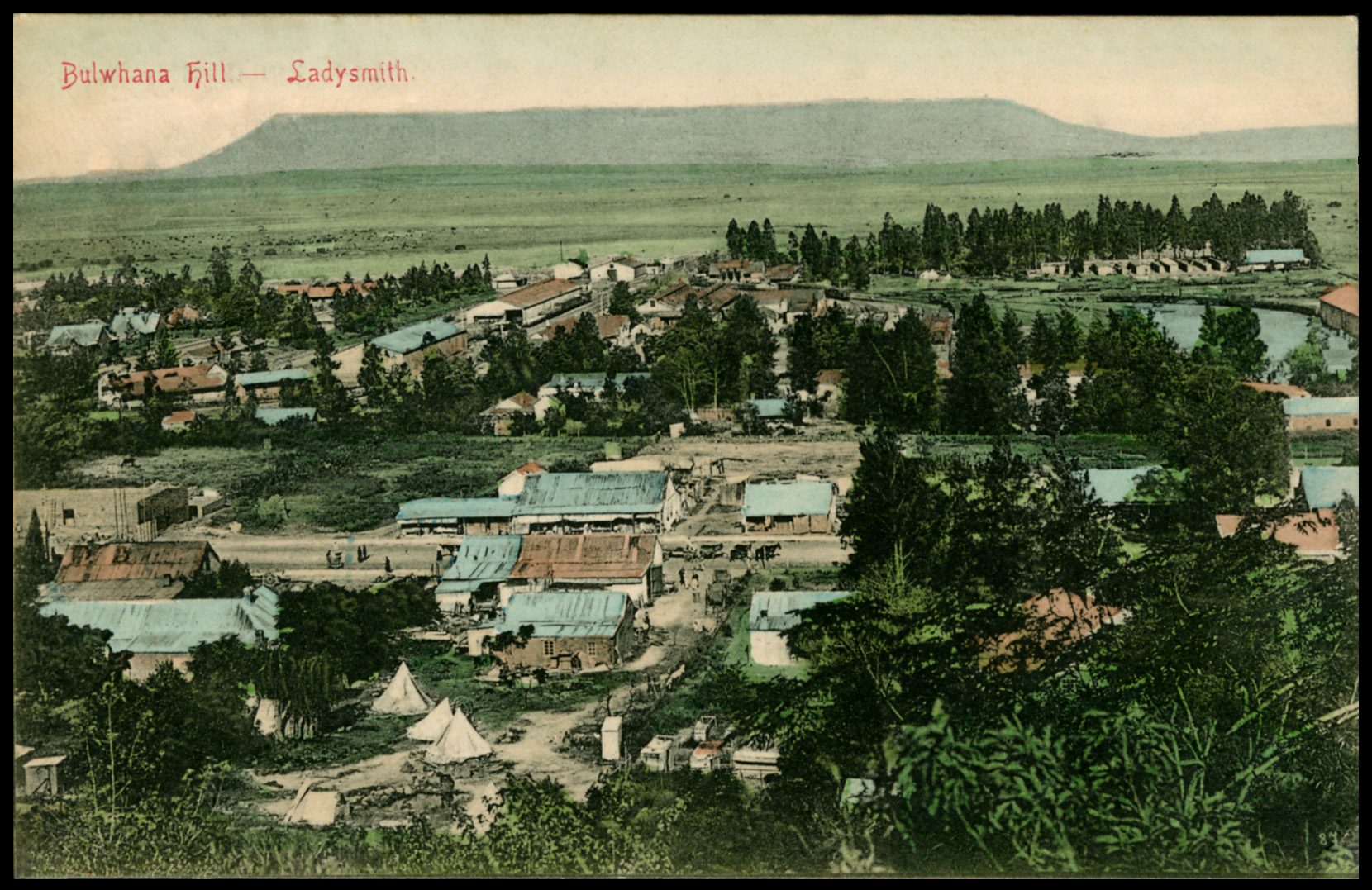
Ladysmith Bulwana Hill
Circa 1902. Postcard. Bulwana Hil – Ladysmith. (Sallo Epstein & Co., Durban. No 1850.)
General Piet Joubert, the Republican commander, established his HQ on Bulwana Hill.
This view is looking to the south-east. In the centre left is the railway yard.
Some 21,000 Boers advanced into northern Natal from the OFS and ZAR. Being too close to the borders, White’s forces were exposed in the triangle of land lying between the two Boer republics. Penn Symons’ force at Glencoe and nearby Dundee fought and won the Battle of Talana Hill on 20th October. However, Penn Symons was mortally wounded and died later in Dundee. He was succeeded by General James Yule. After the Boers captured the railway station at Elandslaagte and severed communications with White, the Battle of Elandslaagte was fought on the following day, the 21st October.
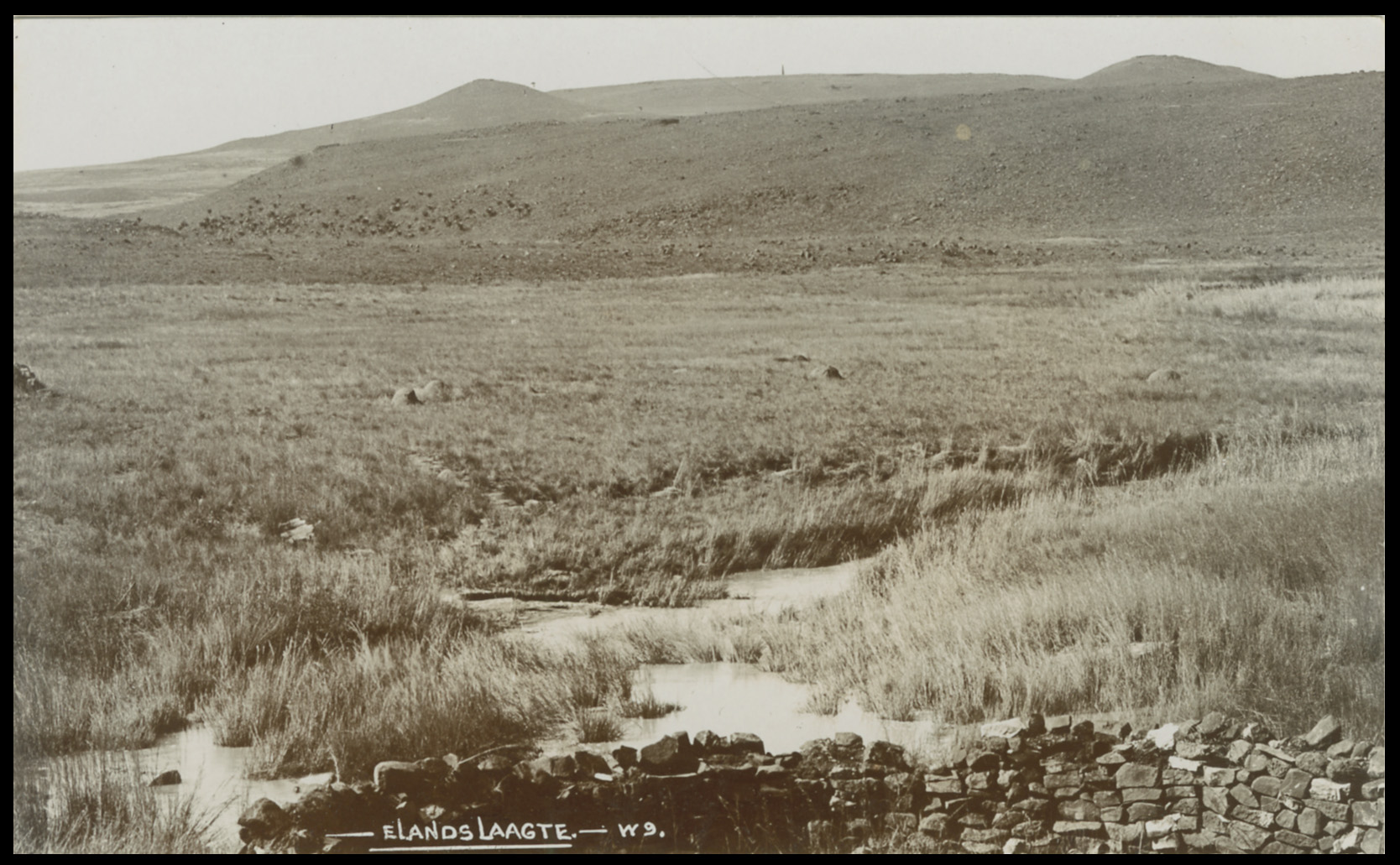
Circa 1906. ‘Real photo’ postcard. Elandslaagte’.
White ordered Major General John French and his cavalry to clear the railway line and restore telegraph communications at Elandslaagte. French’s cavalry were victorious but gained no strategic advantage from the engagement at Elandslaagte. Fearing a further invasion of Boers from the Orange Free State, White decided to withdraw all his forces to Ladysmith. When Yule learned of the situation at Elandslaagte he abandoned Dundee and Glencoe on 22nd October and retreated post hast to Ladysmith in order to avoid being encircled and to reinforce White. Yule’s men reached Ladysmith on 26th October.
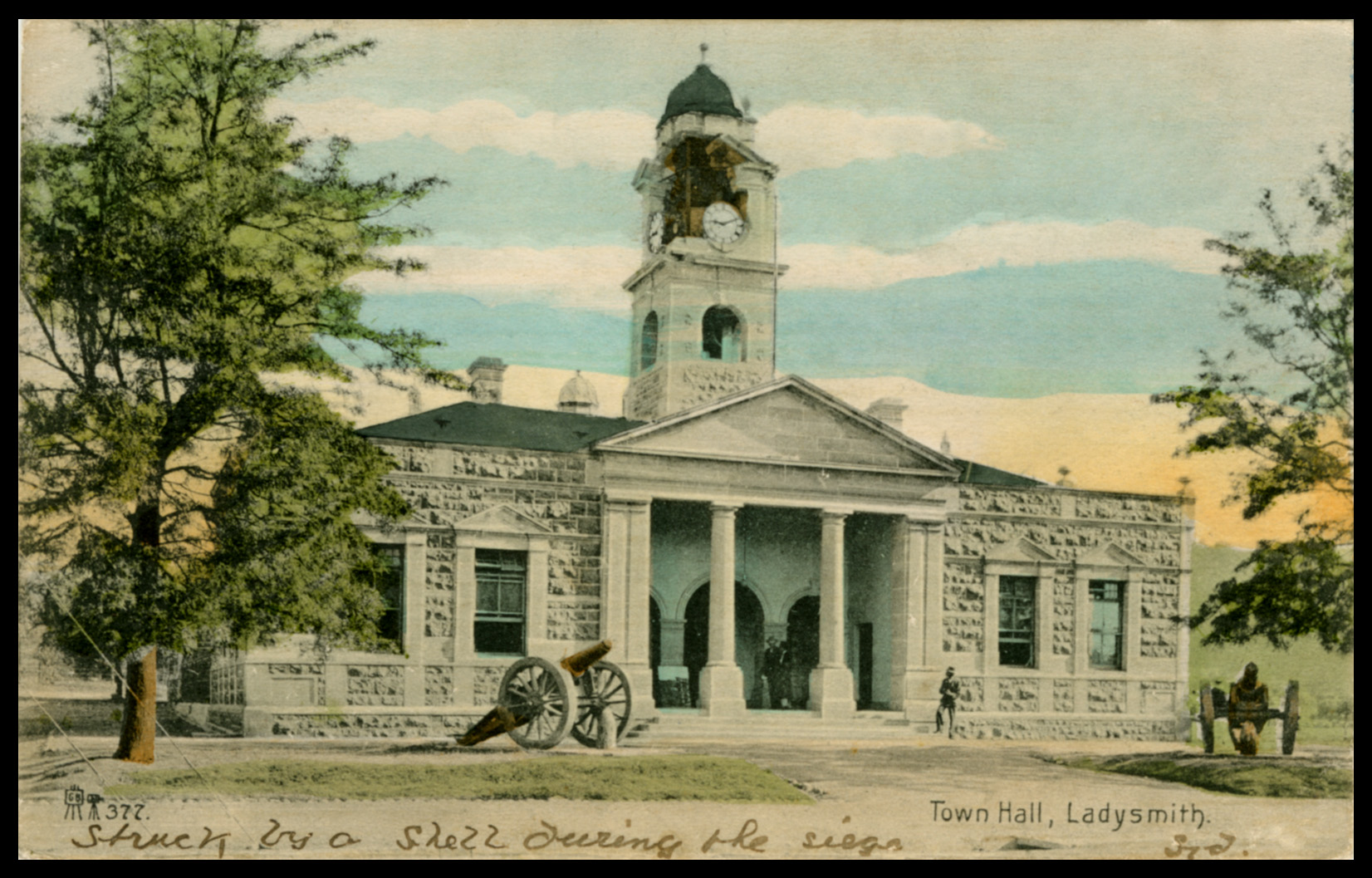
Circa 1902. Postcard. ‘Town Hall, Ladysmith’. (G. B. & Co. No 377.)
The clock tower was not repaired until the late 1920s.
The Republicans slowly began to surround Ladysmith. In response White ordered a sortie by the Ladysmith garrison on 30th October against the surrounding Boer forces with the aim of capturing or destroying the Boer artillery. The resulting Battle of Ladysmith was a demoralising British defeat for the town’s garrison. In what would be a feature of the siege as illustrated on the Siege of Ladysmith postcards the first of many Boer heavy artillery shells from ‘Long Tom’ on Pepworth Hill landed in the town, causing some panic.
Siege of Ladysmith Postcards Continued below....
Quote from Steve on June 3, 2025, 11:01 amSiege of Ladysmith postcards 3.
HMS Terrible and Powerful had a profound military / naval impact on the direction which the South African War was taking in the early days of the Republican invasion of Natal when the Boers threatened to sweep the British Army before them and into the sea. They were, the Boers joked, looking forward to eating bananas on Durban Beach. It looked likely but was not to be. The Boer Commander's caution and poor tactics lost his men the initiative and cost his country the war and its independence. At the last minute the British got heavy naval cannons mounted on gun carriages into Ladysmith on the last train to arrive before the town was surrounded and the siege begun.
Circa 1900. HMS Powerful. (C. W. Faulkner & Co., London. Series No. 517B.)
HMS Powerful provided Scott with four 12 pounder guns. She also ferried them to Durban.
With two of HMS Terrible’s 4.7″ guns they reached Ladysmith on the last train in.The British Army’s field artillery was outgunned by the Republican’s French 155 mm Creusot heavy artillery, nicknamed ‘Long Tom’. Fortunately, Captain Percy Scott of HMS Terrible in Simonstown had had the foresight to prepare carriages for naval guns in case they needed to be used to counter the superior Boer heavy artillery in the field. When the order came Scott had guns removed from his HMS Terrible and also from HMS Powerful. Within days they were en route to Durban at full speed ahead. They were immediately unloaded and railed to Ladysmith with limited ammunition.
Circa 1900. Cabinet Card. (Not a postcard.) ‘New Year’s Greetings’.
Attributed to Earl Robert, illustrator of The Ladysmith Bombshell siege newspaper.
This was almost certainly produced after the siege was lifted.
The gun barrel references HMS Powerful.The Naval Brigade arrived in Ladysmith to serve the two powerful 4.7″ naval guns and four 12 pounders. They arrived during the Battle of Ladysmith and the 12 pounders immediately went into action to counter ‘Long Tom’s’ fire which they temporarily suppressed. However, White’s advancing British infantry were mauled by Republican field artillery and driven back into Ladysmith with 400 men killed or wounded. A detachment of 800 men on Nicholson’s Nek were isolated and forced to surrender.
Circa 1902. Postcard. ‘Shall we ever see Simons Town again’.
Although the butt of Army humour, the Naval Brigade gallantly aided the Army.The Republican noose closed and Ladysmith endured 118 days of siege. As the Boers had no appetite for a frontal assault the British were given time to improve their defences.
Circa 1902. Postcard. ‘A Blockhouse outside Ladysmith’. (Sallo Epstein & Co., Durban.)
During the siege there would be only one serious Boer attack on Ladysmith’s defences. Generally, given their smaller numbers, the Boers preferred to fight defensively from behind entrenchments and or cover. In this conventional stage of the war it was the larger, professional British Army who generally attacked and took the fight to the enemy. The Devonshire Regiment won a notable victory during the Sierge of Ladysmith at Wagon Hill on 6 January 1900, driving stubborn Boer resistance off the hill at bayonet point.
1901. Postcard. BALGOWAN ‘4 MY 01’ to PENANG, Straits Settlemnts ‘JY 5 1901’.
Transitted via PIETERMARITZBURG ‘4 MY 1901’ and COLOMBO, Ceylon ‘MY 28 01’.Conditions within Ladysmith were bearable at first but grim by the time the siege was lifted on 28th February 1900. There was an eventual shortage of food. The lack of clean water lead to enteric fever. By January 1900 only 9.500 out of a garrsion of 13,500 men were fit for duty. In February horses were slaughtered for food as there was no fodder available. Soup from horse extract was known as ‘chervil’. The garrison was too weak to take offensive action even with the imminent arrival of Buller.
Ladysmith Siege Postcards Continued below.....
Siege of Ladysmith postcards 3.
HMS Terrible and Powerful had a profound military / naval impact on the direction which the South African War was taking in the early days of the Republican invasion of Natal when the Boers threatened to sweep the British Army before them and into the sea. They were, the Boers joked, looking forward to eating bananas on Durban Beach. It looked likely but was not to be. The Boer Commander's caution and poor tactics lost his men the initiative and cost his country the war and its independence. At the last minute the British got heavy naval cannons mounted on gun carriages into Ladysmith on the last train to arrive before the town was surrounded and the siege begun.
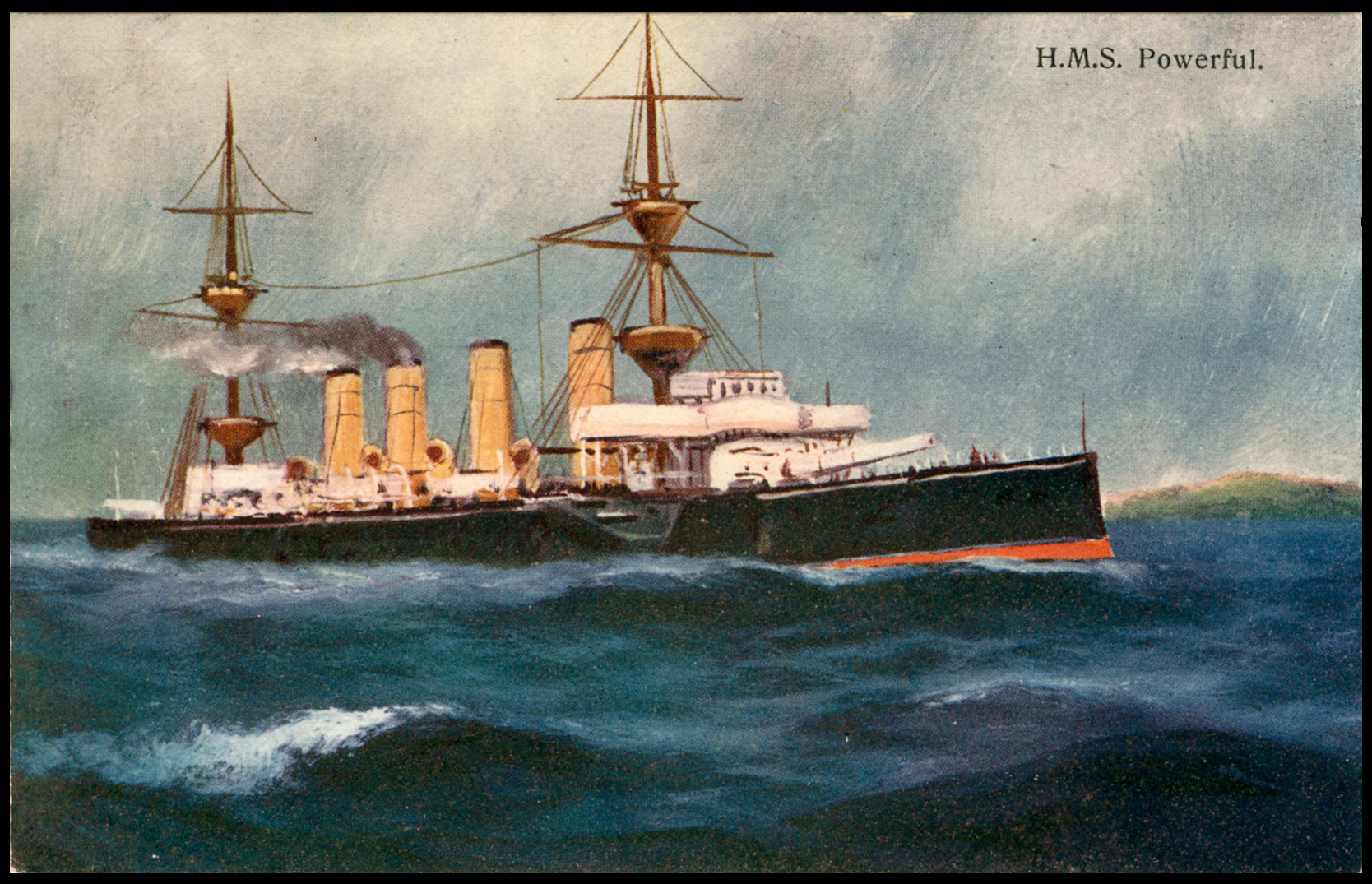
Circa 1900. HMS Powerful. (C. W. Faulkner & Co., London. Series No. 517B.)
HMS Powerful provided Scott with four 12 pounder guns. She also ferried them to Durban.
With two of HMS Terrible’s 4.7″ guns they reached Ladysmith on the last train in.
The British Army’s field artillery was outgunned by the Republican’s French 155 mm Creusot heavy artillery, nicknamed ‘Long Tom’. Fortunately, Captain Percy Scott of HMS Terrible in Simonstown had had the foresight to prepare carriages for naval guns in case they needed to be used to counter the superior Boer heavy artillery in the field. When the order came Scott had guns removed from his HMS Terrible and also from HMS Powerful. Within days they were en route to Durban at full speed ahead. They were immediately unloaded and railed to Ladysmith with limited ammunition.
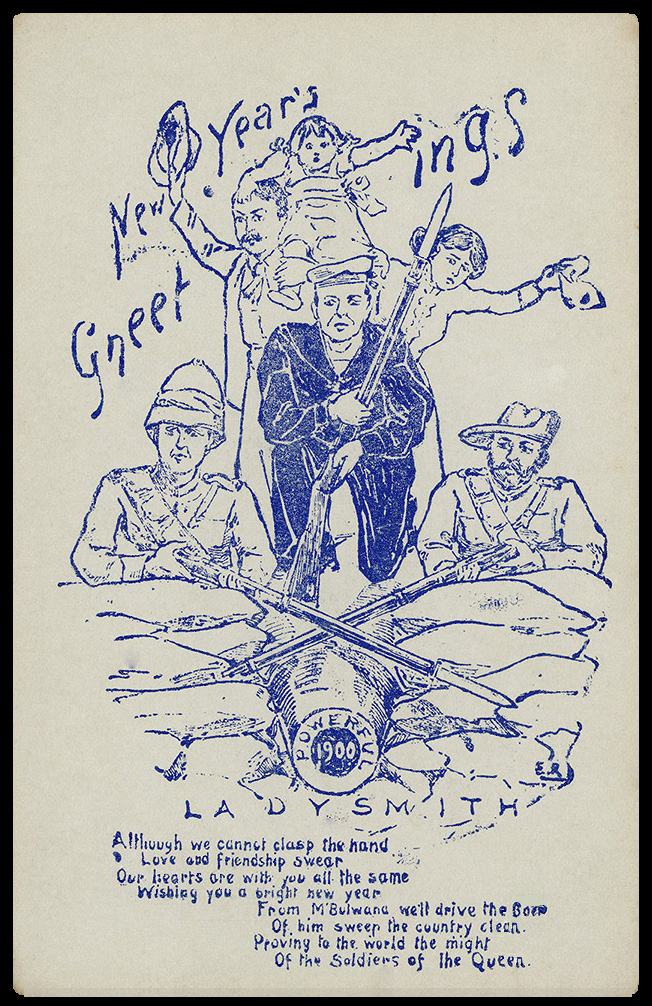
Circa 1900. Cabinet Card. (Not a postcard.) ‘New Year’s Greetings’.
Attributed to Earl Robert, illustrator of The Ladysmith Bombshell siege newspaper.
This was almost certainly produced after the siege was lifted.
The gun barrel references HMS Powerful.
The Naval Brigade arrived in Ladysmith to serve the two powerful 4.7″ naval guns and four 12 pounders. They arrived during the Battle of Ladysmith and the 12 pounders immediately went into action to counter ‘Long Tom’s’ fire which they temporarily suppressed. However, White’s advancing British infantry were mauled by Republican field artillery and driven back into Ladysmith with 400 men killed or wounded. A detachment of 800 men on Nicholson’s Nek were isolated and forced to surrender.
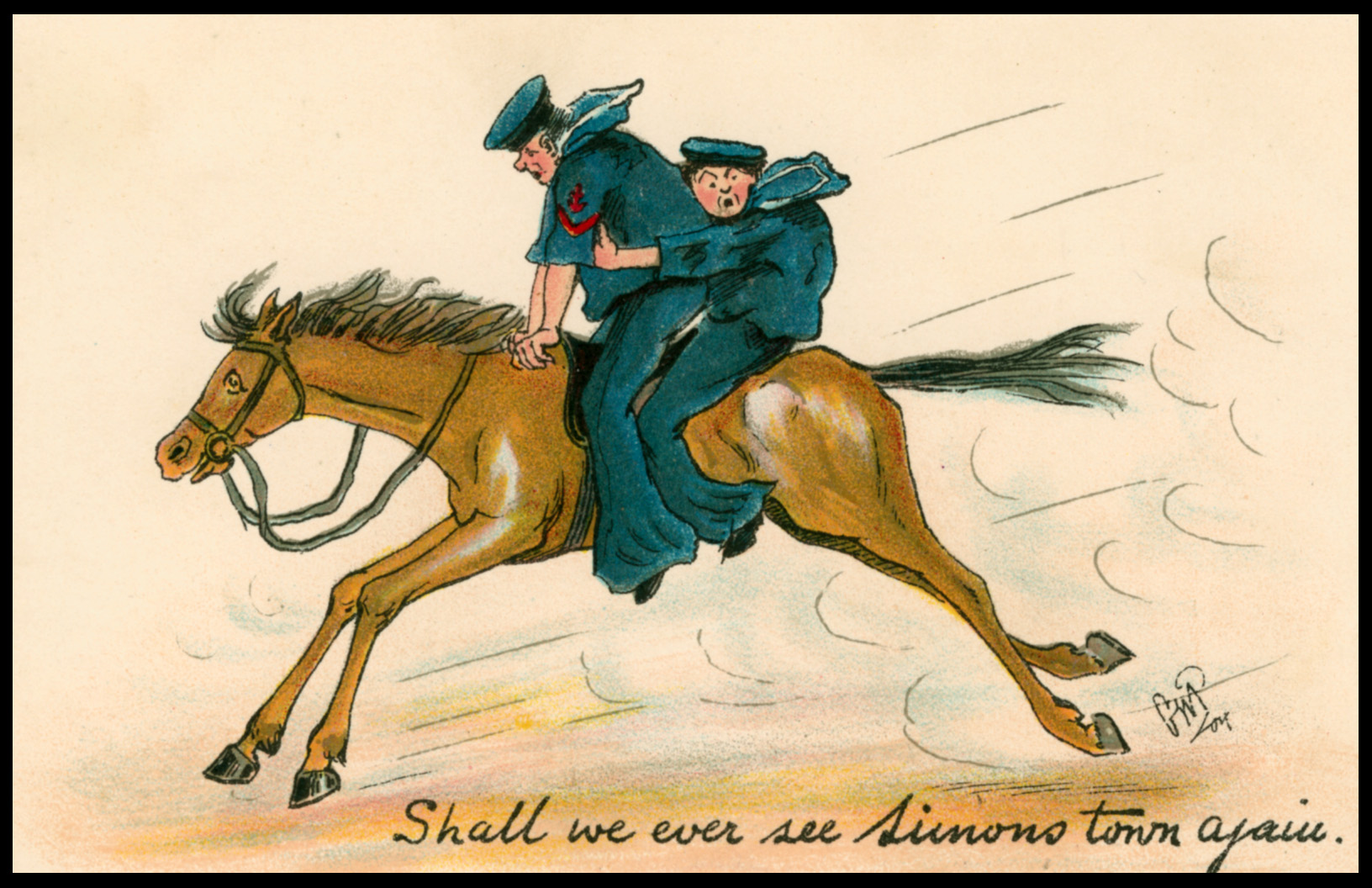
Circa 1902. Postcard. ‘Shall we ever see Simons Town again’.
Although the butt of Army humour, the Naval Brigade gallantly aided the Army.
The Republican noose closed and Ladysmith endured 118 days of siege. As the Boers had no appetite for a frontal assault the British were given time to improve their defences.
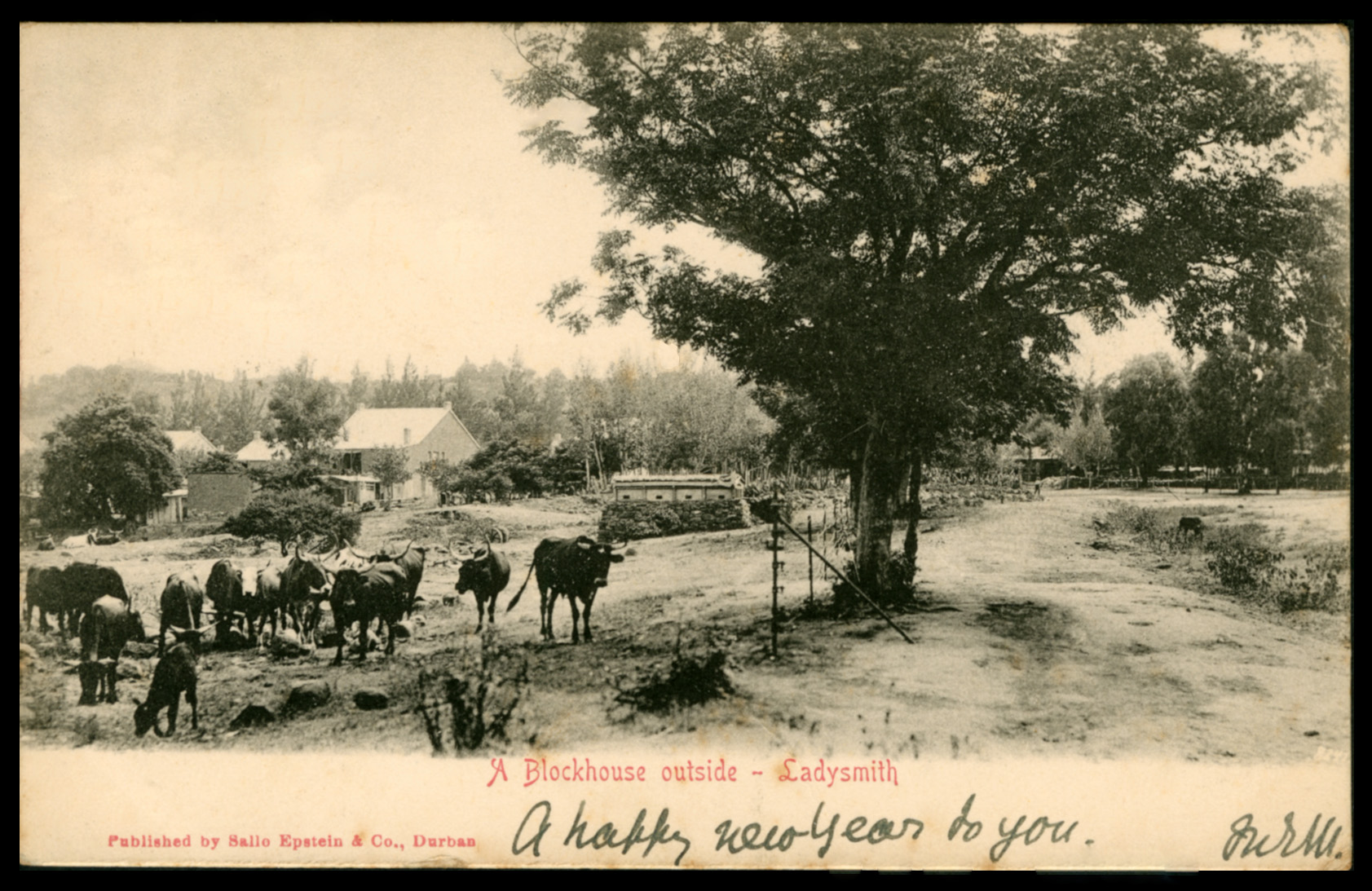
Circa 1902. Postcard. ‘A Blockhouse outside Ladysmith’. (Sallo Epstein & Co., Durban.)
During the siege there would be only one serious Boer attack on Ladysmith’s defences. Generally, given their smaller numbers, the Boers preferred to fight defensively from behind entrenchments and or cover. In this conventional stage of the war it was the larger, professional British Army who generally attacked and took the fight to the enemy. The Devonshire Regiment won a notable victory during the Sierge of Ladysmith at Wagon Hill on 6 January 1900, driving stubborn Boer resistance off the hill at bayonet point.

1901. Postcard. BALGOWAN ‘4 MY 01’ to PENANG, Straits Settlemnts ‘JY 5 1901’.
Transitted via PIETERMARITZBURG ‘4 MY 1901’ and COLOMBO, Ceylon ‘MY 28 01’.
Conditions within Ladysmith were bearable at first but grim by the time the siege was lifted on 28th February 1900. There was an eventual shortage of food. The lack of clean water lead to enteric fever. By January 1900 only 9.500 out of a garrsion of 13,500 men were fit for duty. In February horses were slaughtered for food as there was no fodder available. Soup from horse extract was known as ‘chervil’. The garrison was too weak to take offensive action even with the imminent arrival of Buller.
Ladysmith Siege Postcards Continued below.....
Quote from Steve on June 3, 2025, 12:54 pmSiege of Ladysmith postcards 4.
1900. B&W copy of the cover of a bound set of issues of ‘The Ladysmith Bombshell’.
General Buller, the British commander in South Africa, failed in his attempts to cross the Tugela to relieve Ladysmith. He was decisively beaten back by General Louis Botha at the Battle of Colenso during Black Week, (three British defeats at Stormberg, Magersfontein and Colenso between Sunday 10 December – Sunday 17 December 1899.) With Lord Roberts en route to SA to replace him, Buller finally crossed the Tugela to relieve Ladysmith on 28th February 1900, thereby restoring his reputation to some extent. Roberts would defeat the Republicans in the first conventional phase of the war but after capturing Pretoria he yielded command of the British Army in South Africa to General Kitchener for the more difficult and costly second phase of guerilla warfare.
Circa 1902. Postcard. The Tugela. ‘Where General Buller crossed in the distance”.
(SECD – Sallo Epstein Co., Durban).Both White and Buller were criticised for their lack of military success. White was faulted for retreating to Ladysmith. However, the siege did tie up large numbers of Boers who would have served the Republican cause better elsewhere. Arguably the greatest failure of the siege lay with the Republican leader, General Joubert, whose caution deprived the Boers of victory. His reluctance to release his commandos against White’s forces as they streamed back in disarray to Ladysmith was regarded by Louis Botha, the Boer’s best general and Joubert’s successor, as the most significant Republican failure during the invasion of Natal.
Siege of Ladysmith postcards 4.
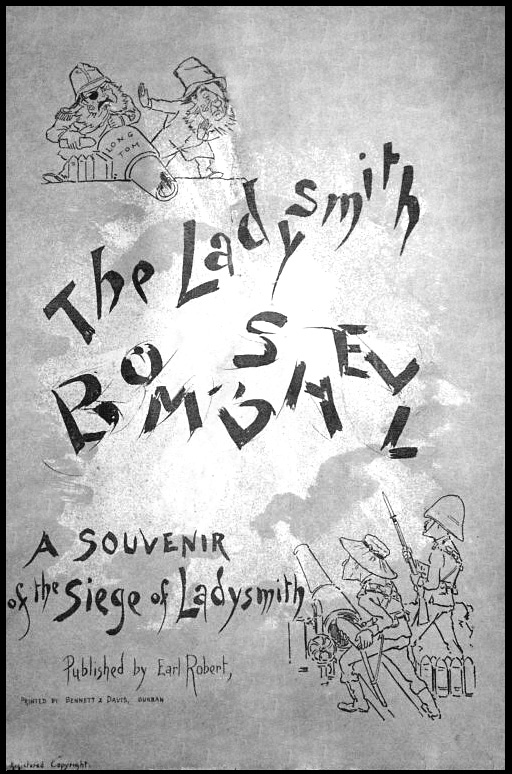
1900. B&W copy of the cover of a bound set of issues of ‘The Ladysmith Bombshell’.
General Buller, the British commander in South Africa, failed in his attempts to cross the Tugela to relieve Ladysmith. He was decisively beaten back by General Louis Botha at the Battle of Colenso during Black Week, (three British defeats at Stormberg, Magersfontein and Colenso between Sunday 10 December – Sunday 17 December 1899.) With Lord Roberts en route to SA to replace him, Buller finally crossed the Tugela to relieve Ladysmith on 28th February 1900, thereby restoring his reputation to some extent. Roberts would defeat the Republicans in the first conventional phase of the war but after capturing Pretoria he yielded command of the British Army in South Africa to General Kitchener for the more difficult and costly second phase of guerilla warfare.
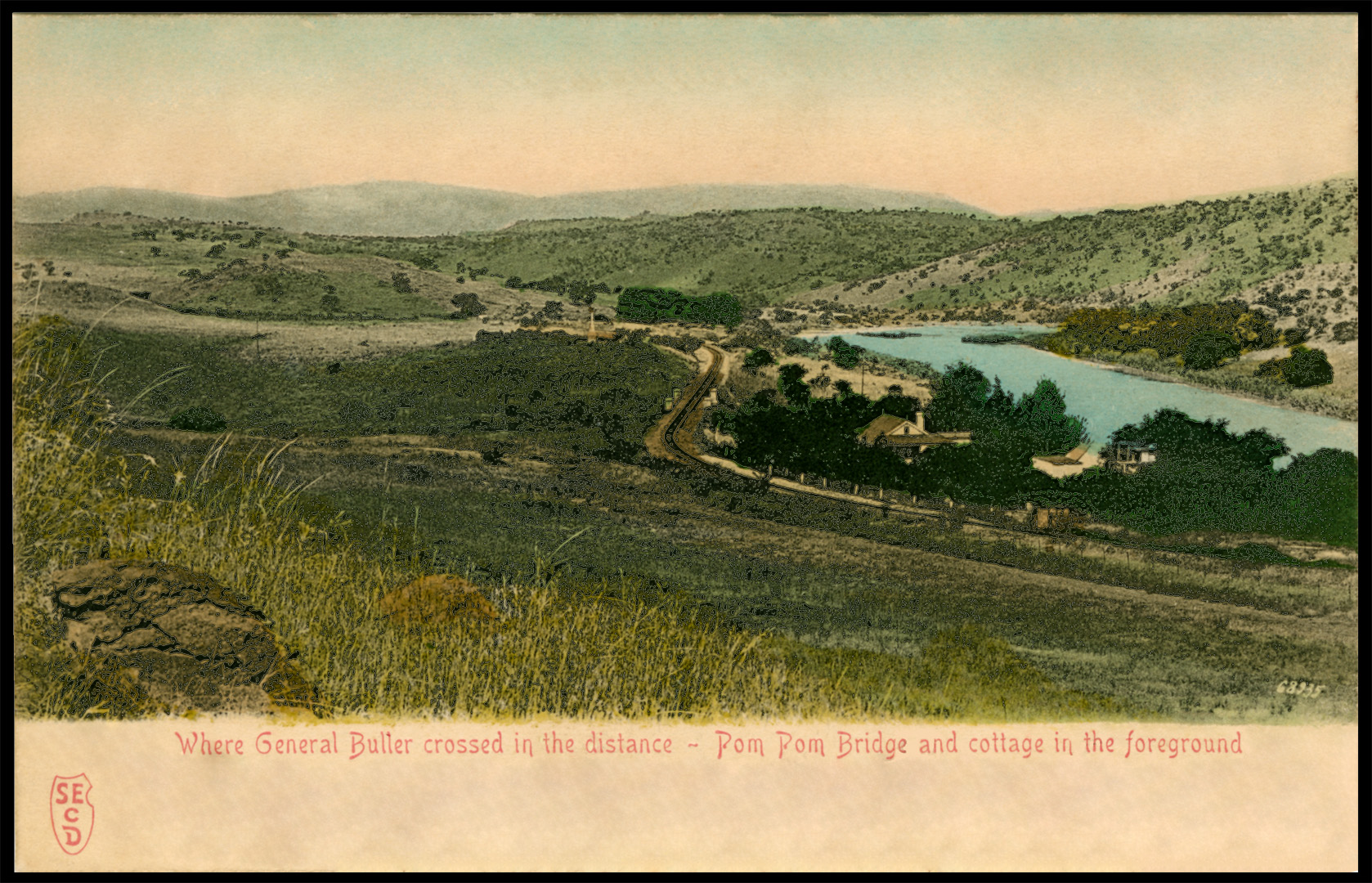
Circa 1902. Postcard. The Tugela. ‘Where General Buller crossed in the distance”.
(SECD – Sallo Epstein Co., Durban).
Both White and Buller were criticised for their lack of military success. White was faulted for retreating to Ladysmith. However, the siege did tie up large numbers of Boers who would have served the Republican cause better elsewhere. Arguably the greatest failure of the siege lay with the Republican leader, General Joubert, whose caution deprived the Boers of victory. His reluctance to release his commandos against White’s forces as they streamed back in disarray to Ladysmith was regarded by Louis Botha, the Boer’s best general and Joubert’s successor, as the most significant Republican failure during the invasion of Natal.
Quote from Steve on September 12, 2025, 10:18 amLike most sieges, the surrounded and embattled British soldiers in Ladysmith eventually began to run out of food. This led to cuts in their rations. To avoid malnutrition and ultimately death they were forced to eat the cavalry's horses. A product which they called 'chervil', a thin soup, was made from them. The postcard below shows the British defenders of Ladysmith as centaurs, half-man, half horse. In Greek mythology, centaurs have the upper body, head, and arms of a human and the lower body, legs, and hindquarters of a horse. (In the image below the 'horses' have human feet.) Known for their wild and often lawless behavior, centaurs enjoyed fighting and revelry in equal measure, a bit like your average shilling-a-day British Tommy. The drawing below suggests the British sense of humour in adversity. The British have two fatalistic phrases for this, like - "gallows humour" and "trench humour" - essentally an attempts to lighten the mood in grim situations.
1900. Cabinet Card. (Not a postcard.) 'The Siege Valentine'.
"In commemoration of the horsheflesh diet called Chevril. Siege of Ladysmith. 14th February, 1900."The above is taken from Kenny Napier's Paulshof Auction - 13th September 2025.
"LOT 69. South Africa ABW Siege of Ladysmith silver coloured cabinet card picture entitled " The Siege Valentine- In commemoration of the horseflesh diet called Chevril, 14th February 1900". Produced by H.Kisch of Ladysmith. Henry Kisch (1847-1902) was a photographer active in South Africa. During the siege of Ladysmith he was the only professional photographer within Ladysmith. Two books showing his photographs from the siege were published. R1200 - R1500
If you do not receive Kenny Napier's auction notifications, you can email him a request to go on his international email list.
Click here to email Kenny to get on his mailing list.
Like most sieges, the surrounded and embattled British soldiers in Ladysmith eventually began to run out of food. This led to cuts in their rations. To avoid malnutrition and ultimately death they were forced to eat the cavalry's horses. A product which they called 'chervil', a thin soup, was made from them. The postcard below shows the British defenders of Ladysmith as centaurs, half-man, half horse. In Greek mythology, centaurs have the upper body, head, and arms of a human and the lower body, legs, and hindquarters of a horse. (In the image below the 'horses' have human feet.) Known for their wild and often lawless behavior, centaurs enjoyed fighting and revelry in equal measure, a bit like your average shilling-a-day British Tommy. The drawing below suggests the British sense of humour in adversity. The British have two fatalistic phrases for this, like - "gallows humour" and "trench humour" - essentally an attempts to lighten the mood in grim situations.
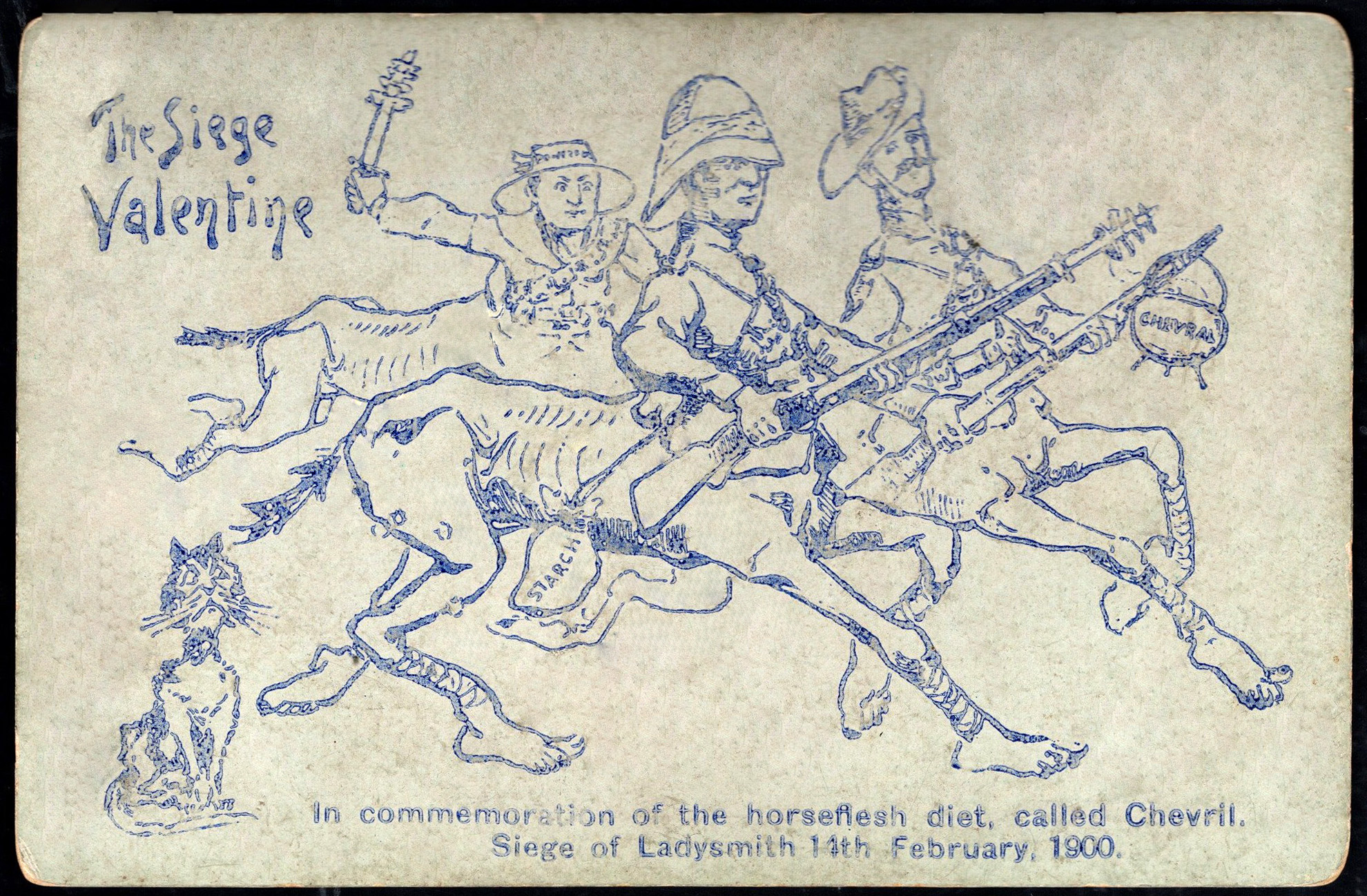 1900. Cabinet Card. (Not a postcard.) 'The Siege Valentine'.
1900. Cabinet Card. (Not a postcard.) 'The Siege Valentine'.
"In commemoration of the horsheflesh diet called Chevril. Siege of Ladysmith. 14th February, 1900."
The above is taken from Kenny Napier's Paulshof Auction - 13th September 2025.
"LOT 69. South Africa ABW Siege of Ladysmith silver coloured cabinet card picture entitled " The Siege Valentine- In commemoration of the horseflesh diet called Chevril, 14th February 1900". Produced by H.Kisch of Ladysmith. Henry Kisch (1847-1902) was a photographer active in South Africa. During the siege of Ladysmith he was the only professional photographer within Ladysmith. Two books showing his photographs from the siege were published. R1200 - R1500
If you do not receive Kenny Napier's auction notifications, you can email him a request to go on his international email list.
Click here to email Kenny to get on his mailing list.
Quote from Steve on October 23, 2025, 3:55 pmThe Railway Bridge at Colenso
1903. Postcard. COLENSO '17 MY 03' to NKANDLE, ZULULAND.
This postcard dates just under one year after the end of the South African / Anglo-Boer War - 1899 - 1902.The image on this postcard is interesting and perplexing. If you can advise, please do so.
During the 1899 South African War, the Republican forces occupied the northern hills surrounding Colenso which lay on the opposite south bank of the Tugela river. In order to relieve Ladysmith the British had to first cross the Tugela, ideally using one of the two bridges at Colenso. Commandant General Joubert reluctantly gave the order to dynamite the railway bridge in 28th November 1899. The bridge, originally built over the Tugela river in 1885 was a strategic crossing point that was demolished to hinder British forces.
The Boer General Louis Botha immediately recognised that the ground around Colenso was ideal for a defensive battle. The northern bank of the Tugela which the Boers occupied is dominated by a chain of high koppies below which the river follows in a meandering course that creates a series of great loops. The small village of Colenso lay in the middle of one of these loops in no-man's land. The Boers were ordered by Botha to fortify the low hills around Colenso. Any force moving through the village to cross the Tugela by the bridge would be subject to fire from three sides. With the railway bridge destroyed the British would have to ford the Tugela. With his tactical advantage, Louis Botha was able to inflict heavy casualties on the attacking British forces.
The problem with this postcard is that it makes no sense - or rather the facts srrounding it don't add up!
The question is "what is shown in this postcard and when?" There is some suggestion that the railway bridge was blown up twice, partially at first and then more comprehensively with all the spans destroyed. If true, this postcard must show the first partial destruction before Colonel John Blake's Irish Volunteers placed 40 loads of dynmite beneath the 154 metre and blew it sky high. Or is this is the bridge during its reconstruction. But what about the claimed road bridge? Was the railway and road bridge one and the same?
The British moaned mightily about this destruction being more than was militarily neccessary. The Boers did not like it either! They were hard-pressed by Colonel John Blake, the American West Pointer, serving with them to do it. It is not in the make-up of farmers to destroy homes and infrastructure unnecessarily. The Boers knew the work and the cost involved in building something from nothing.
Circa 1880. The Bridge intact. Built 1878.
The Colenso bridge was built in 1885 as part of the Maritzburg-Ladysmith railway extension. It does not appear to be dual purpose ie. both road and rail use. So, where is the road bridge that is talked about, the one that was left intact?
1899.The railway Bridge destroyed. 28th November, 1899.
The Railway Bridge at Colenso
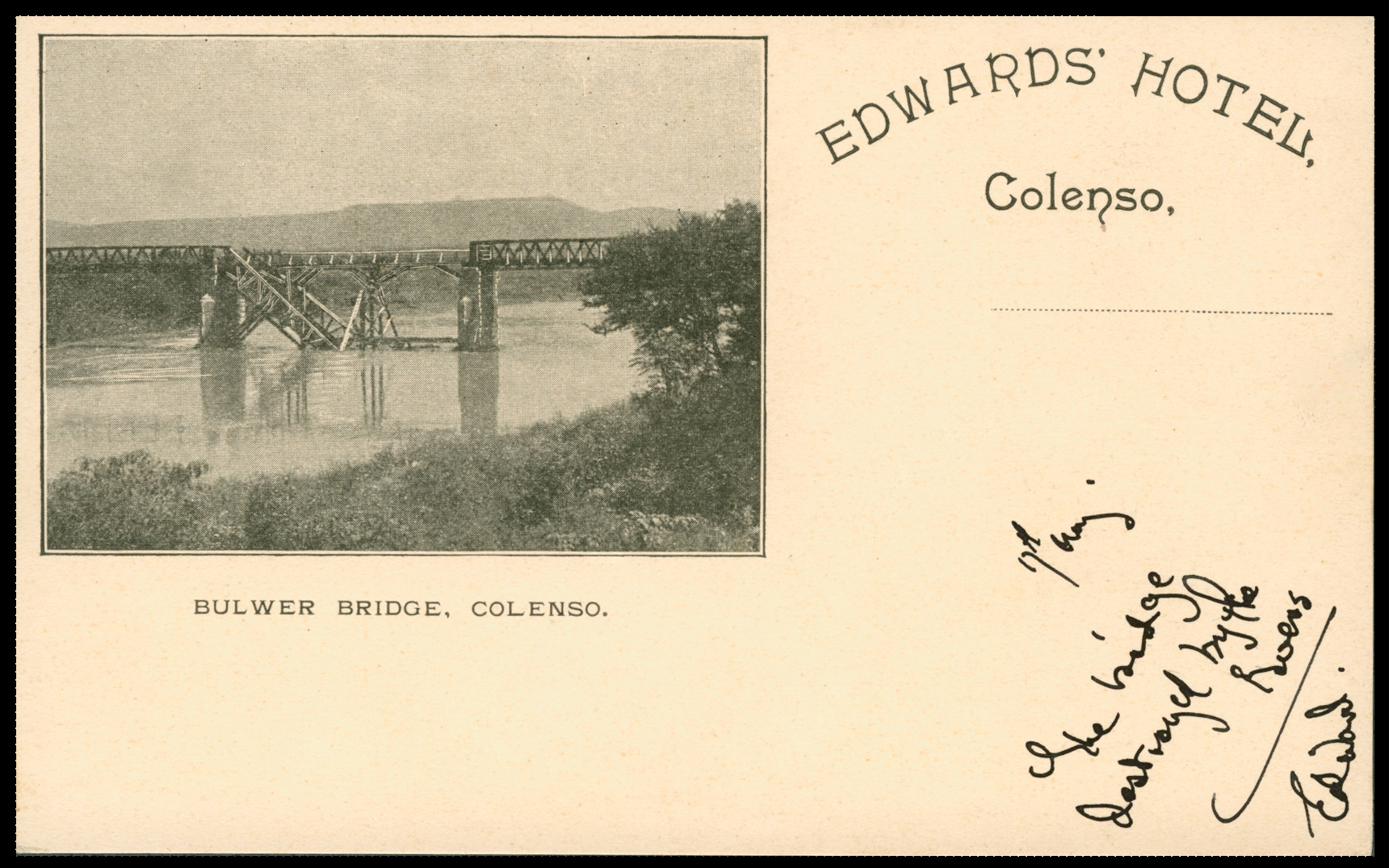
1903. Postcard. COLENSO '17 MY 03' to NKANDLE, ZULULAND.
This postcard dates just under one year after the end of the South African / Anglo-Boer War - 1899 - 1902.
The image on this postcard is interesting and perplexing. If you can advise, please do so.
During the 1899 South African War, the Republican forces occupied the northern hills surrounding Colenso which lay on the opposite south bank of the Tugela river. In order to relieve Ladysmith the British had to first cross the Tugela, ideally using one of the two bridges at Colenso. Commandant General Joubert reluctantly gave the order to dynamite the railway bridge in 28th November 1899. The bridge, originally built over the Tugela river in 1885 was a strategic crossing point that was demolished to hinder British forces.
The Boer General Louis Botha immediately recognised that the ground around Colenso was ideal for a defensive battle. The northern bank of the Tugela which the Boers occupied is dominated by a chain of high koppies below which the river follows in a meandering course that creates a series of great loops. The small village of Colenso lay in the middle of one of these loops in no-man's land. The Boers were ordered by Botha to fortify the low hills around Colenso. Any force moving through the village to cross the Tugela by the bridge would be subject to fire from three sides. With the railway bridge destroyed the British would have to ford the Tugela. With his tactical advantage, Louis Botha was able to inflict heavy casualties on the attacking British forces.
The problem with this postcard is that it makes no sense - or rather the facts srrounding it don't add up!
The question is "what is shown in this postcard and when?" There is some suggestion that the railway bridge was blown up twice, partially at first and then more comprehensively with all the spans destroyed. If true, this postcard must show the first partial destruction before Colonel John Blake's Irish Volunteers placed 40 loads of dynmite beneath the 154 metre and blew it sky high. Or is this is the bridge during its reconstruction. But what about the claimed road bridge? Was the railway and road bridge one and the same?
The British moaned mightily about this destruction being more than was militarily neccessary. The Boers did not like it either! They were hard-pressed by Colonel John Blake, the American West Pointer, serving with them to do it. It is not in the make-up of farmers to destroy homes and infrastructure unnecessarily. The Boers knew the work and the cost involved in building something from nothing.
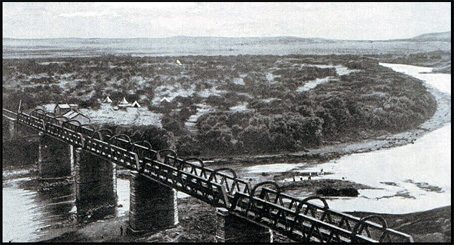
Circa 1880. The Bridge intact. Built 1878.
The Colenso bridge was built in 1885 as part of the Maritzburg-Ladysmith railway extension. It does not appear to be dual purpose ie. both road and rail use. So, where is the road bridge that is talked about, the one that was left intact?
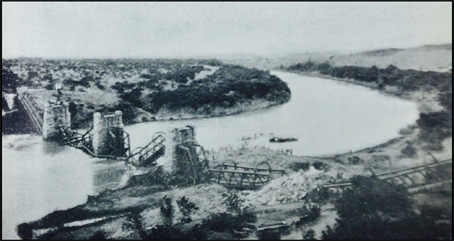
1899.The railway Bridge destroyed. 28th November, 1899.
Quote from Steve on November 23, 2025, 12:45 pmI found this postcard in a lot of material that I bought at auction. It is not particularly remarkable but it does have something to say. The subject is a 'Boer Patrol on the Plains of Natal in March 1900'. It suggest perhaps that the Republican forces in Natal are advancing. It would be a nice item to include as an image in any display on the Boer invasion of Natal and the early success that they enjoyed there.
1901. Belgian Postcard. UITENHAGE (Holland!) '6 JAN 01' to TEN HAGE.
However, the date of March 1900 on the front of this postcard reveals a different reality. At this time the war had begun to turn against the Boers. General Cronje had surrendered at Paardeberg in the OFS on 27th February. General De Wet was driven from Poplar Grove on 7th March. Bloemfontein fell to Lord Roberts on the 13th. It was a month in which Boer forces would be in retreat everywhere. To cap it off, Commandant-General Piet Joubert who had done so much to arm the Boers would die in Pretoria at the end of the month.
This Belgian postcard was produced by 'Louis van Eck, Anvers' as editor of the 'Transvaal Series'. It is not one of the more insidiously anti-British European propaganda postcards of the South African War. It is what it is, a simple photograph in a series of similar images revealing aspects of the war. So, with the date being March 1900, the Question is "is this Boer patrol advancing or retreating? The answer, I guess, depends on the needs of your display "The Boers are either advancing boldly in anticipation of eating bananas on Durban Beach" or "they are assuming a brave military bearing for the photographer before taking headling flight for Home".
I found this postcard in a lot of material that I bought at auction. It is not particularly remarkable but it does have something to say. The subject is a 'Boer Patrol on the Plains of Natal in March 1900'. It suggest perhaps that the Republican forces in Natal are advancing. It would be a nice item to include as an image in any display on the Boer invasion of Natal and the early success that they enjoyed there.
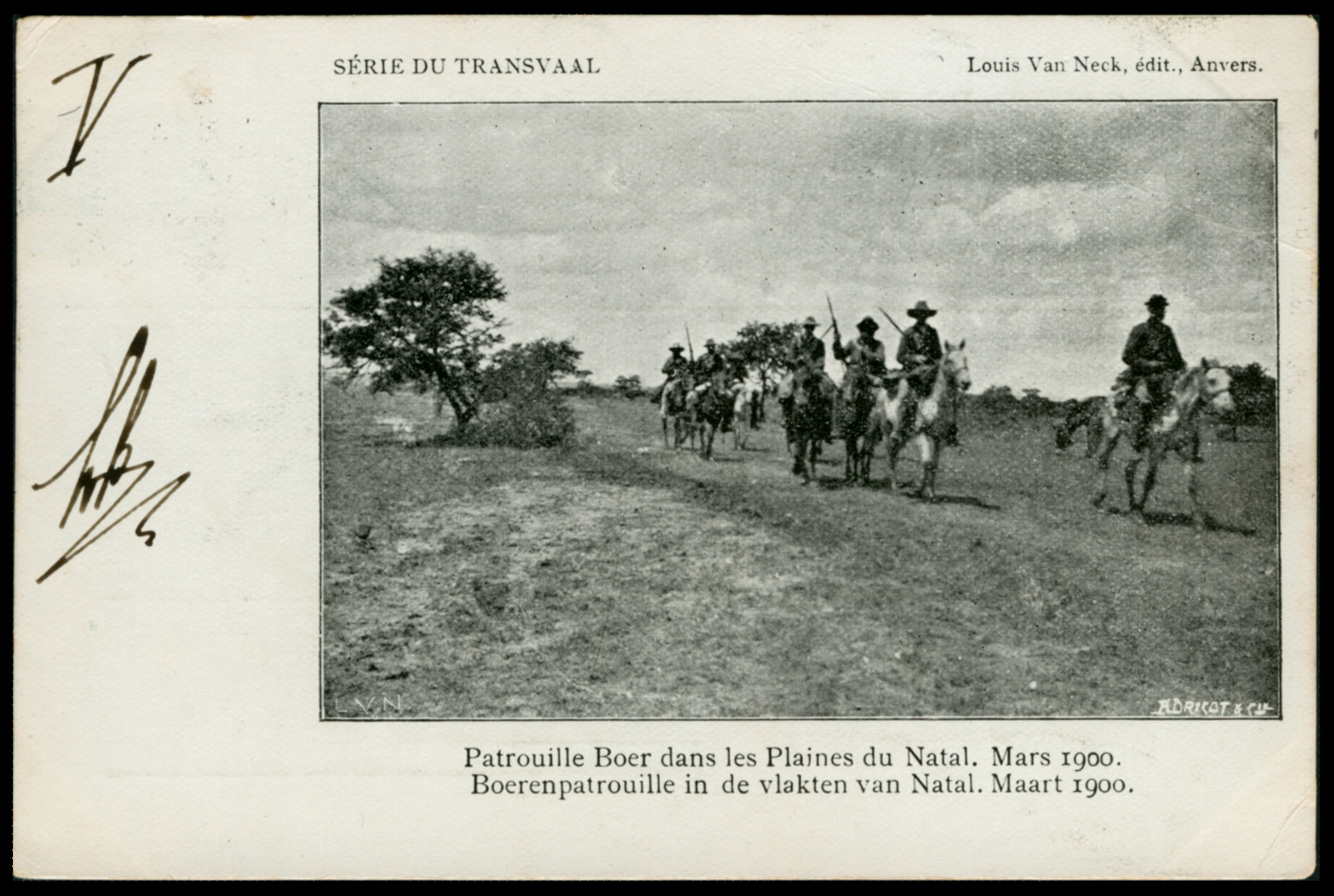
1901. Belgian Postcard. UITENHAGE (Holland!) '6 JAN 01' to TEN HAGE.
However, the date of March 1900 on the front of this postcard reveals a different reality. At this time the war had begun to turn against the Boers. General Cronje had surrendered at Paardeberg in the OFS on 27th February. General De Wet was driven from Poplar Grove on 7th March. Bloemfontein fell to Lord Roberts on the 13th. It was a month in which Boer forces would be in retreat everywhere. To cap it off, Commandant-General Piet Joubert who had done so much to arm the Boers would die in Pretoria at the end of the month.
This Belgian postcard was produced by 'Louis van Eck, Anvers' as editor of the 'Transvaal Series'. It is not one of the more insidiously anti-British European propaganda postcards of the South African War. It is what it is, a simple photograph in a series of similar images revealing aspects of the war. So, with the date being March 1900, the Question is "is this Boer patrol advancing or retreating? The answer, I guess, depends on the needs of your display "The Boers are either advancing boldly in anticipation of eating bananas on Durban Beach" or "they are assuming a brave military bearing for the photographer before taking headling flight for Home".
Quote from Steve on December 28, 2025, 11:36 amThere is an interesting postcard of the Royal Hotel, Ladysmith, in the 'Hotels of southern Africa' thread. The Royal Hotel was situated close to the Town Hall and was hit at least once by Boer artilley shells. During the siege “The Bombshell commented that “there was a time at the Royal when you had eggs inside and shells outside, now you don’t”. Click here to see the Royal Hotel post. (Scroll down.)
There is an interesting postcard of the Royal Hotel, Ladysmith, in the 'Hotels of southern Africa' thread. The Royal Hotel was situated close to the Town Hall and was hit at least once by Boer artilley shells. During the siege “The Bombshell commented that “there was a time at the Royal when you had eggs inside and shells outside, now you don’t”. Click here to see the Royal Hotel post. (Scroll down.)
